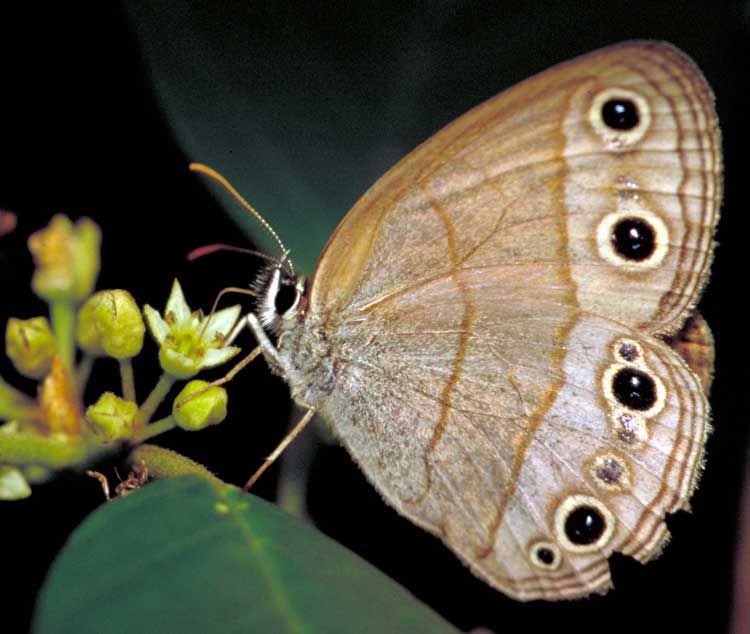
Megisto cymela, Photo: U.S. Fish and Wildlife Service
Superregnum: Eukaryota
Cladus: Unikonta
Cladus: Opisthokonta
Cladus: Holozoa
Regnum: Animalia
Subregnum: Eumetazoa
Cladus: Bilateria
Cladus: Nephrozoa
Cladus: Protostomia
Cladus: Ecdysozoa
Cladus: Panarthropoda
Phylum: Arthropoda
Subphylum: Hexapoda
Classis: Insecta
Cladus: Dicondylia
Subclassis: Pterygota
Cladus: Metapterygota
Infraclassis: Neoptera
Cladus: Eumetabola
Cladus: Endopterygota
Superordo: Panorpida
Cladus: Amphiesmenoptera
Ordo: Lepidoptera
Subordo: Glossata
Cladus: Coelolepida
Cladus: Myoglossata
Cladus: Neolepidoptera
Infraordo: Heteroneura
Cladus: Eulepidoptera
Cladus: Ditrysia
Cladus: Apoditrysia
Cladus: Obtectomera
Superfamilia: Papilionoidea
Familia: Nymphalidae
Subfamilia: Satyrinae
Tribus: Satyrini
Subtribus: Euptychiina
Genus: Megisto
Species: Megisto cymela
Subspecies: (2)
M. c. cymela – M. c. viola
Name
Megisto cymela (Cramer, 1777)
Type locality: South Africa.
Synonyms
Papilio cymela Cramer, 1777
Papilio eurytus Fabricius, 1775, Syst. Ent.: 487 (preocc. Papilio eurytus Linnaeus, 1758)
Papilio eurytris Fabricius, 1793, (emend.)
References
Cramer, 1777, Uitl. Kapellen 2 (9-16): 55, pl. 132, f, C, D.
Miller, L.D., 1976: Revision of the Euptychiini (Satyridae). 3. Megisto Hübner. Bulletin of the Allyn Museum 33: 1–23.
Vernacular names
English: Little Wood Satyr
Megisto cymela, the little wood satyr, is a butterfly species of the Satyrinae family that occurs in North America.
Description
Ventral view
Adult
The wingspan is 29–48 mm. The forewing has two yellow-rimmed black eyespots on both sides, dorsal and ventral. The hindwing has two spots on the dorsal side but have smaller spots on the ventral. The other all color is light brown. The wood satyr is comparably larger than sosybia.
Caterpillar
The body is light greenish brown with a dark dorsal line and alternating brown and yellowish lateral stripes. The surface of the caterpillar has bumps, these bumps bear short reddish-brown hairs. The head is dirty white while the tail hairs are light gray.
The wood satyr is part of the typically Neotropical subtribe Euptychiina. It can be observed in forests, usually along the edges and in brush-filled openings along cleared forest roads. It has also been observed in grassy areas usually between forested patches. It flies near the ground, twisting between and through grasses, small trees and bushes. Collectors have found it often difficult to capture, though it appears to be a slow flyer at first glance. This butterfly prefers habitat that is open, contains deciduous trees along with marshy areas and possessing brushy cover.[2]
Range and habitat
They are seen in the eastern United States and southeastern Canada, from Nova Scotia south into Florida, west to Texas, Saskatchewan and Wyoming. As the name implies the little wood satyr is most commonly seen in woods and shrubby areas.[3]
Life cycle
Adults in the northern portions of their range fly between June and July while their southern populations fly between March and September. Adults have a slow "bouncing" flight but they will rise as far as the top of tall trees. Females lay eggs singly on grass, the fourth-instar caterpillars hibernate.
Larval foods
Dactylis glomerata
Poa pratensis
Eremochloa ophiuroides
Adult foods
Plant sap
Aphid honeydew
Rarely nectar
References
"NatureServe Explorer 2.0 Megisto cymela Little Wood Satyr". explorer.natureserve.org. Retrieved 29 September 2020.
Klotz, Alexander B. (1951). a Field Guide to the Butterflies of North America, East of the Great Plains. Peterson Field Guide Series (first ed.). Boston: Houghton Mifflin Company. p. 69. ISBN 0395078652.
Klotz, Alexander B. (1951). a Field Guide to the Butterflies of North America, East of the Great Plains. Peterson Field Guide Series (first ed.). Boston: Houghton Mifflin Company. p. 64. ISBN 0395078652.
Bibliography
Wikimedia Commons has media related to Megisto cymela.
"Species Megisto cymela - Little Wood Satyr - BugGuide.net". Retrieved 2008-11-20.
"Megisto Hübner, [1819]" at Markku Savela's Lepidoptera and Some Other Life Forms
"Species Detail Butterflies and Moths of North America". Archived from the original on 2009-07-16. Retrieved 2008-11-20.
Retrieved from "http://en.wikipedia.org/"
All text is available under the terms of the GNU Free Documentation License

